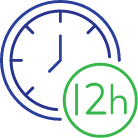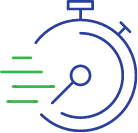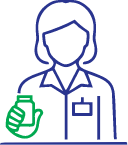
Back pain
If you suffer from back pain, you’re not alone. Around 1 in 6 Australians are affected by back problems; that’s around 4 million people.1,2 Back pain can occur anywhere along the spine, most commonly in the lower back.3,4
While most back pain generally resolves on its own within days or weeks, its effects can be debilitating if not effectively managed in the short-term.1-3 The good news? There are many things that you can do to live well despite back pain, and minimise its potential impact on your work, social life and mental health.1-5 Find out more below.

Understanding back pain
Back pain refers to pain that affects any area of your spine or the surrounding muscles, nerves and tissues. It includes the area from your neck to your buttocks. While back pain can affect any area of the back, it most commonly affects the lower back, also known as the lumbar spine. Most people report experiencing low back pain at some point in their lives.3,4
Most back pain is classified as 'acute', meaning it starts suddenly and lasts for a relatively short
period of time, usually resolving on its own.1,3
Causes of back pain
More than 9 out of 10 cases of back pain are not caused by a serious medical problem or damage to the spine. Most commonly, acute back pain comes from the muscles, ligaments and joints, and is a result of something you did like a sudden twisting movement while playing sport, a fall or accident, or overdoing it in the garden.1,5
Some common causes of acute back pain include:1,3,5
- Repetitive or heavy lifting
- Sudden awkward movement
- Soft tissue sprains and strains
- Lack of exercise / Not getting enough physical activity
- Being overweight or obese
- Stress and muscle tension
- Poor sleep
- Sudden or unusual increase in spinal loading – for example, if you are carrying moving boxes or if you have a sick child and have to lift and carry them more than usual.
Less commonly, back pain has a specific cause like arthritis, a fracture or herniated (slipped) disk. If your back pain does not go away after a few weeks, you should see your doctor to investigate the possibility of a specific cause that may require specific management.1
Symptoms of back pain
The experience of back pain can range from a generalised muscle ache to a shooting, burning or stabbing feeling. In some cases, pain may radiate down one or both legs.5,6
Back pain may be exacerbated with certain movements like bending, twisting, lifting, standing or walking. Because of this, it is common for people with back pain to restrict certain daily activities.5,6
The trouble with restricted movement is that staying active is key to recovering from back pain.3 Find out how you can keep active while managing back pain below.
Managing acute back pain
Acute back pain usually disappears when the underlying cause (e.g. a muscle injury) has healed.5
So, while back pain usually goes away on its own, if it’s causing you distress and impacting your life, there are things you can do to manage pain while the underlying injury heals.1
Fortunately, the most effective treatments involve things you can do yourself:1,3,5
- Keep physically active: Did you know that resting your back can actually make the pain worse? In the case of back pain, movement is medicine. Start slowly, and gradually increase the intensity of your exercise over time. A physiotherapist can help with this.
- Maintain a healthy weight and quit smoking.
- Manage your stress levels: Stress makes pain worse by contributing to muscle tension and spasm.
- Relaxation and mindfulness.
However, keeping active despite back pain can be difficult if the pain is restricting your movement. To help you get back on your feet, you may need to use pain relief medicines for a short period.1,3 Anti-inflammatory medicines like CELEBREX RELIEF® work to reduce pain and inflammation, and may be a suitable treatment option for the short-term treatment of acute back pain due to muscle or joint injury.7 Ask your pharmacist if this treatment is right for you.
When to see a doctor
While most back pain improves over time with simple treatment and physical activity, see your doctor if the pain lasts longer than a few weeks, or if it is affecting your ability to sleep or perform daily tasks.3,6
Do not use CELEBREX RELIEF® for more than 5 days at a time, unless advised by a doctor.
You should also contact your doctor if you have:1,3
- Pain that is severe, and gets worse over time instead of better
- A fever accompanying your back pain
- Problems controlling your bladder or bowel
- Numbness, pins and needles in your legs or feet
- Weakness in your legs or unsteadiness on your feet
- Unexplained weight loss
- Redness or swelling on your back
These may be signs of a specific cause that will need to be treated before the pain can resolve.
Related Articles

Shoulder pain can result from injuries, overuse, or underlying conditions

An ankle sprain is an injury to the ligaments that support the ankle pain

Primary dysmenorrhea is characterised by severe menstrual cramps
ASK YOUR PHARMACIST ABOUT THIS PRODUCT. INCORRECT USE COULD BE HARMFUL.
CELEBREX RELIEF® contains celecoxib 200 mg 10 Capsules. Indications: For the short-term treatment of acute pain in adults with musculoskeletal and/or soft tissue injury, and primary dysmenorrhoea. Recommended dose: A loading dose of 2 capsules on day 1, then 1 capsule once or twice daily, as required for up to 5 days.
References:
1. Musculoskeletal Health Australia. Back pain. Accessed April 2024. 2. Australian Institute of Health and Welfare (AIHW). Back problems. Accessed November 2024. 3. Australian Commission on Health and Quality in Health Care. Low Back Pain Clinical Care Standard. Accessed November 2024. 4. Healthdirect. Back pain – an overview. Accessed November 2024. 5. Better Health Channel, Victoria State Government Department of Health. Back pain. Accessed November 2024. 6. Mayo Clinic. Back pain. Accessed November 2024. 7. CELEBREX RELIEF® Consumer Medicine Information. 8. Cheung R et al. Clin Ther 2007;29:2498–510. Funded by Pfizer Inc.



